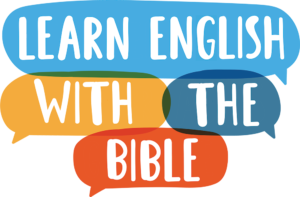
Welcome to Your Study Section
In this section of the website, you will find lessons to study on your own. In each lesson, we will study a Bible story or passage. The lessons are divided into three sections – beginner, intermediate, and advanced.
What Is My English Level?
If you aren’t sure what level of English you have, here’s a link to a free online test that will help you: https://www.efset.org/
If you’d like to know more about finding out what level of English you have, check out this blog post on how to determine your level of English.
If I Am a Beginner, Should I Only Do Beginner Lessons?
No! You may do any of the lessons at any time You may also repeat any lesson as many times as you like. If you are a beginner, doing an intermediate lesson may take you more time and be more difficult, but you may learn more. If you are good at English, doing a beginner lesson may help you review basic rules and help you feel more confident with what you already know.
What If I Don’t Have Time To Do the Entire Lesson?
If you don’t have time to do the entire lesson, you can focus on the parts of each lesson that will help you the most. For example, if you are good at reading English, but have trouble with listening, you can do the listening section and skip the reading section. It’s up to you! So grab your notebook and pen, and use these lessons in the way that will help you the most.
How Do the Lessons Work?
The seven parts of each lesson are listed below. Start with the Listening exercise. As you finish one part, click on the link at the bottom of the page, and you will move to the next part.
The individual lessons may also be found in order on their individual pages. For example, all the Reading exercises will also be found in order on the Reading Exercises page. All the Writing exercises will also be found on the Writing Exercises page.
1. Listening Exercise
Listen to the passage and find the answers to 4 questions. Listen again and again, because you will understand more each time you listen. Listen to how English speakers put stress on certain words and syllables. Listen for peculiar pronunciations, like the “eh” sound of the schwa. But don’t worry if you don’t understand everything! Just click the button at the bottom of the page to continue to the Reading Exercise.
2. Reading Exercise
In the Reading exercise, you will see the story written for you. Read through it several times. Again, don’t worry if you don’t understand every word!
Try to understand the meaning of words you don’t know in the context of the sentence they are in. After all, this is how you would use English in a real conversation. You wouldn’t ask the speaker to stop for a minute so you could look up a word, right? You would just continue to listen! Many times, other words the speaker says will help you understand the meaning of what he is saying.
You may also download a PDF of the reading text. If you download the PDF, you can read while you listen to the audio – this is also a great way to study both listening and reading.
After you’ve done your best to read the passage, move on to the Vocabulary Exercise.
3. Vocabulary Exercise
In this exercise, we’ll examine 5 or 6 of the words or expressions in the passage that might give you trouble. This would be a great time for you to head to your dictionary, or to WordReference.com, and do a little studying on your own to cement the meanings of these words in your brain! When you have studied the vocabulary words, move on to the Speaking and Pronunciation Exercise.
4. Speaking Exercise
In this exercise, you can listen to the audio again. This time, pause the recording after several words, and repeat them out loud. Try to imitate the speaker’s stress patterns and intonation. Do the whole passage, or choose one part to do again and again until you feel comfortable.
When you have practiced saying the text out loud a few times, we’ll dig a little deeper into English with the Grammar Exercise.
5. Grammar Exercise
In these lessons, we’ll take a brief look at one grammar element from the passage. You may also find some brief written grammar exercises to do. After the Grammar Exercise, you’ll do a short Writing Exercise.
6. Writing Exercise
In this exercise, you will find a new audio recording. You’ll hear one short section of the passage three times. The first time, just listen. The second time, you will hear a few words, then a pause. During the pauses, do you best to write what you hear. And finally, the speaker will repeat the entire verse again so you can check your work. You can also return to the Reading exercise to see the verse written for you. And last, we will put everything together with some thinking questions about the Bible text in this lesson.
7. Discussion Questions
It isn’t enough to just read the Bible. God wants us to learn about Him, and to do everything we can to live a life that is pleasing to Him. Take some time to consider some questions about the Bible passage you just studied. Write your answers in your notebook – in your own language, or in English. Discuss the questions with a friend. And most importantly, pray to God about what you learned and ask Him to help you follow Him more closely!
I hope these lessons will be helpful for you!
Now, click the button to go to the main lessons page.
